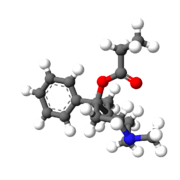Proheptazine
 | |
 | |
| Clinical data | |
|---|---|
| ATC code | none |
| Legal status | |
| Legal status |
|
| Identifiers | |
| |
| CAS Number | 77-14-5 |
| PubChem (CID) | 60969 |
| ChemSpider |
54931 |
| UNII |
S23189WW7E |
| ECHA InfoCard | 100.000.916 |
| Chemical and physical data | |
| Formula | C17H25NO2 |
| Molar mass | 275.39 g/mol |
| 3D model (Jmol) | Interactive image |
| |
| |
| (verify) | |
Proheptazine is an opioid analgesic from the phenazepine family. It was invented in the 1960s.[1]
Proheptazine produces similar effects to other opioids, including analgesia, sedation, euphoria, dizziness and nausea.
In the United States it is a Schedule I Narcotic controlled substance with an ACSCN of 9643 and a 2013 annual aggregrate manufacturing quota of zero. The salts in use are the citrate (free base conversion ratio 0.589), hydrobromide (0.773), and hydrochloride (0.883). [2][3]
References
- ↑ Diamond J, Bruce WF, Tyson FT. Synthesis and Properties of the Analgesic DL-α-1,3-dimethyl-4-phenyl-4-propionoxyazacycloheptane (Proheptazine). Journal of Medicinal Chemistry. 1964 Jan;7:57-60.
- ↑ http://www.deadiversion.usdoj.gov/fed_regs/quotas/2014/fr0825.htm
- ↑ http://www.deadiversion.usdoj.gov/quotas/conv_factor/index.html
This article is issued from Wikipedia - version of the 4/2/2016. The text is available under the Creative Commons Attribution/Share Alike but additional terms may apply for the media files.